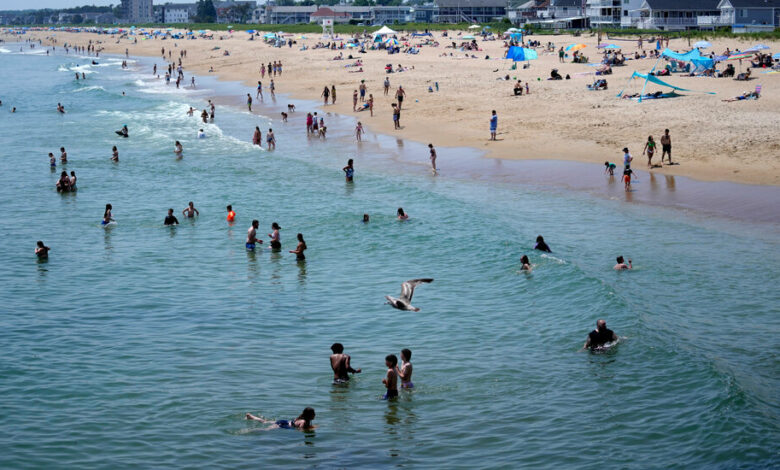Rural America lags behind cities when it comes to helping people cope with the heat

In Caribou, Maine, a town of 7,400, the splash pad was packed with children at noon Wednesday as temperatures soared. But next door, in a cooling center for the country’s many elderly residents, all the folding chairs were empty, even as three air conditioners blew an icy breeze.
Officials had spread the news about the Aroostook County cooling center on social media, on radio stations and TV, and in local newspapers. In Maine and much of rural America, however, the techniques known in cities to help people beat the heat are much harder to implement effectively.
“But we’re here,” said Gary Marquis, the director of the Caribou Parks and Recreation Department.
Much of the country was boiling this week as temperatures rose in Maine and other areas unaccustomed to mid-June heat waves. In many cities, residents cooled off in shady parks, jumped in public pools or hydrated with cold water handed out by paramedics and police officers stationed at busy intersections or in public transit hubs — all tactics that health officials are encouraging to help prevent heat-related illnesses.
These types of strategies are common in many cities, as they are effective in areas with large populations. In more rural areas, however, people are much more dispersed and much harder to reach.
“We are missing a large part of our society, and a part that tends to have higher levels of chronic disease, older populations and lower incomes,” said Kevin Lanza, assistant professor of environmental sciences at UTHealth Houston in Austin. “All three are factors that increase the serious risk to rural communities in the face of climate change.”
Some of America’s most heat-sensitive populations are far removed from places like Phoenix, one of America’s hottest cities. In fact, this past July, Phoenix experienced 31 consecutive days in which temperatures reached or exceeded 110 degrees Fahrenheit.
But places that are traditionally less hot — such as parts of Maine, Wisconsin and even North Dakota and Alaska — are considered among the most socially vulnerable in the country to exposure to extreme heat, according to for research by the US Census Bureau. This is partly because they are much less accustomed to — and less prepared for — extreme heat. Risk factors include poor housing quality, limited transportation options and significant financial hardship, which, when piled on top of rising temperatures, put them at risk.
In Maine, for example, a heat wave this early in the season complicates the usual ways to cool down. While residents have access to swimming facilities in some areas, some public pools have yet to open. People living in coastal areas could theoretically take a dip in the ocean, but at this time of year it can be dangerous. The water temperatures are still so cold that hypothermia is a risk.
The decision to open cooling centers is left up to individual communities in Maine, said Vanessa Corson, spokeswoman for the Maine Emergency Management Agency.
“If cooling centers are not open in less populated, rural areas of the state, or if cooling centers are too far away, people are advised to go to a public place with air conditioning, such as a store, restaurant or library,” she said in an email. “Every individual or household should have a preparedness plan for situations like this.”
In Aroostook County, which shares a border with Canada, Mr. Marquis said officials had asked him only once before about opening a cooling center at the Caribou Recreation Center, about two years ago. No one came then either, he said.
On Wednesday, the opening was complicated by the federal holiday Juneteenth: employees had the day off. But Mr. Marquis said he found an employee willing to staff the center in case anyone needed a break from the heat.
Maybe some people will come in when temperatures rise, he said Wednesday afternoon.
Researchers who study heat have focused on tactics to bring relief to urban areas, not only because of their population density, but also because cities, with their miles of dark asphalt and widespread lack of trees, get hotter than the surrounding countryside. Developing new strategies to bring heat relief to rural areas has been neglected.
“Cooling centers and the like work in urban areas, but they don’t work as well in rural areas,” he said. Ashley Wardthe director of the Heat Policy Innovation Hub at Duke University, whose work focuses on the health impacts of climate extremes and community resilience.
People who need help may live far from libraries, police stations and fire stations that serve as cooling centers in smaller cities. “We need interventions that fit the environment,” she said. “We have to do better.”
Jason Troyer, director of the Emergency Management Agency in Holmes County, Ohio, said education is his biggest tool. He’s focused on telling people to stay out of the sun between noon and 6 p.m., which he said is difficult for a rural workforce that includes farmers, carpenters and roofers. He urges people to wear loose, cool clothing and stay hydrated.
Nearly half of Holmes County’s roughly 45,000 residents are Amish, he said, and they shun electricity. The community is often more accustomed to heat than others accustomed to air conditioning, he said, so it seems its members are doing better. Mr. Troyer is also captain of the East Holmes Fire and Emergency Medical Services District and said he hasn’t seen an increase in calls for heat-related emergencies in the community in recent years.
Many rural areas in the US are also low-income areas with mobile homes and trailers, which, due to their poor insulation, can feel like they are baking their residents in hot weather.
“Even though people have access to air conditioning, they can’t afford to run it at the high temperatures that they need,” said Maggie Sugg, an associate professor in the department of geography and planning at Appalachian State University, who has studied heat vulnerability in North and South Carolina. “We have policies that say utilities can’t turn off the heat in cold weather, but we don’t have the same kind of policies for heat. We need to treat heat the same way we treat cold weather.”
Officials are appealing for federal funding to help install a type of heat pump that works well in manufactured homes, said Michael Stoddard, the executive director of Efficiency Mainean independent agency that implements energy efficiency programs.
Heat pumps have become popular in Maine because they offer a cheaper, more energy-efficient way to heat homes during cold winters than oil furnaces. They pull heat from the outside air, even in subzero temperatures, and then pump it indoors. And in the summer, they can work in reverse, pulling heat from the building and pumping it outside, cooling the interior.
But until recently, cooling was a secondary issue.
“We live in a part of the country that has never needed air conditioning before,” Mr Stoddard said. “Now it is becoming clear that it is quite necessary to have cooling in the summer.”
Jon Barrett, who lives in Winterport, Maine, about 15 miles from Bangor, said he bought two heat pumps in October to prepare for winter. He’s been running them non-stop for the past few days, even at night.
“I have them cooling both the upstairs and downstairs,” he said. “And they work great.”




